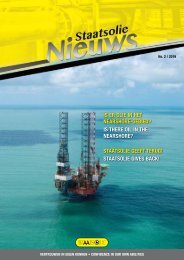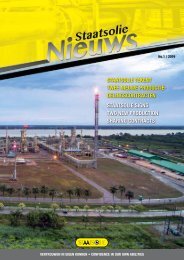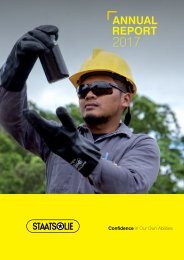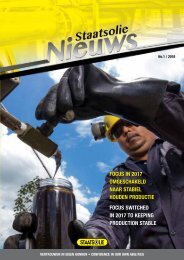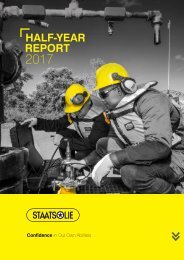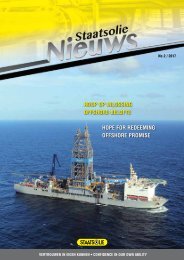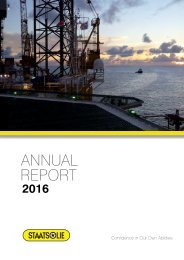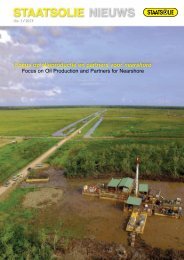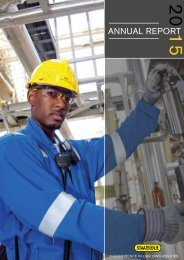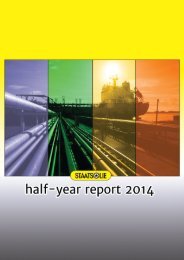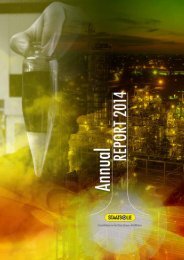Staatsolie Nieuws Oktober 2016
Create successful ePaper yourself
Turn your PDF publications into a flip-book with our unique Google optimized e-Paper software.
De controlekamer van de raffinaderij.<br />
The refinery control room.<br />
De afgelopen maanden hebben zich gekenmerkt door tegenslagen met falen van<br />
of storingen aan equipment, waardoor productietargets niet constant zijn gehaald.<br />
Zo zijn er relatief veel stroomonderbrekingen geweest. Naar aanleiding daarvan<br />
is een verbeteringsprogramma ingezet bij dochtermaatschappij SPCS die de<br />
stroom aanlevert. Er waren ook lichtpunten de afgelopen tijd. In mei produceerde<br />
de raffinaderij iets boven haar targets aan hoogwaardige eindproducten premium<br />
diesel en gasoline, en eind maart en april draaide de waterstoffabriek zelfs op<br />
91% van haar capaciteit. Van 27 tot 30 juni is succesvol de finale acceptatie<br />
ofwel 72-uurs test uitgevoerd. Bij deze test moet de raffinaderij 72 uur onafgebroken<br />
draaien. <strong>Staatsolie</strong> heeft als bewijs van goedkeuring een certificaat van<br />
Saipem ontvangen waaruit blijkt dat de raffinaderij conform het ontwerp kan produceren.<br />
Na dit resultaat is de constructiecontractor niet meer verantwoordelijk.<br />
In augustus behaalde <strong>Staatsolie</strong> de mijlpaal van 1 miljoen geproduceerde barrels<br />
premium diesel en gasoline.<br />
The past months have been characterized by setbacks caused by failure or malfunction of equipment,<br />
resulting in many production targets not being met optimally. There were relatively many<br />
power blackouts. This has forced implementation of an improvement program at subsidiary SPCS<br />
which supplies the electrical power. Fortunately, there were uplifting moments in the past period. In<br />
May the refinery’s production of high quality end products (premium diesel and gasoline) exceeded<br />
its targets and at the end of March and April the hydrogen factory even operated at 91 percent of<br />
its capacity. From 27 through 30 June the final acceptance or 72-hour test was successfully carried<br />
out. <strong>Staatsolie</strong> received a certificate of approval from Saipem, proving that the refinery is able to<br />
produce according to the design. After achievement of this result, the construction contractor is no<br />
longer responsible for the refinery. In August the refinery reached the 1 million barrels milestone of<br />
produced premium diesel and gasoline.<br />
Learning Process<br />
The organization has until the end of this year to<br />
complete all preparations. ‘The refinery will be shut<br />
down by mid-January 2017 and we aim at restarting<br />
within four weeks’, says Aziez. ‘The most challenging<br />
aspect of the operation is removing the catalyst<br />
from the two pieces of equipment. It’s challenging<br />
because we’ve never done this before and it requires<br />
other expertise. When removing the catalyst the<br />
unit’s temperature is cooled down with nitrogen to<br />
40˚C. Under normal circumstances the temperature<br />
is between 490˚C and 544˚C.’<br />
Even the equipment, the isolated rooms where the<br />
employees will be working, has to be kept at room<br />
temperature. It requires constant monitoring and<br />
optimal safety requirements. ‘It will be a learning<br />
process for us.’<br />
<strong>Staatsolie</strong> <strong>Nieuws</strong> • No. 2 • <strong>2016</strong><br />
19






